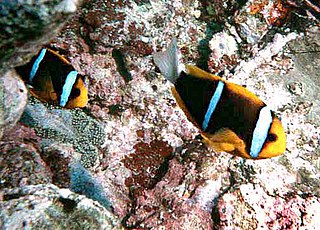
The orange-fin anemonefish is a marine fish belonging to the family Pomacentridae, the clownfishes and damselfishes, found in the Western Pacific north of the Great Barrier Reef from the surface to 20 m, to include the Pacific Ocean between Queensland, Australia, and New Guinea to the Marshall and Tuamotus Islands. It can grow to 17 cm in length.

Schultz's pipefish, Corythoichthys schultzi, is a pipefish of the family Syngnathidae.

The bird wrasse, Gomphosus varius, is a species of the wrasse family.

The slingjaw wrasse is a species of wrasse from the family Labridae which is native to the tropical waters of the Indo-Pacific where it occurs around coral reefs. This species is of minor importance to local commercial fisheries and can be found in the aquarium trade. Relatively mundane at first glance, this fish is notable for its highly protrusible jaws.
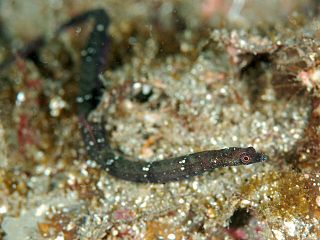
Halicampus is a genus of pipefishes of the family Syngnathidae, containing 12 described species.
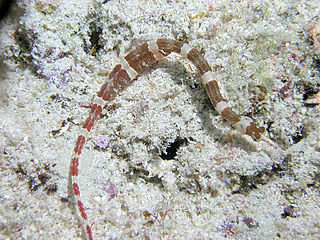
Corythoichthys amplexus, known commonly as the brown-banded pipefish, is a species of marine fish in the family Syngnathidae.
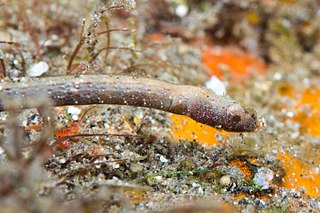
Halicampus dunckeri or also commonly known as the Duncker's pipefish or ridgenose pipefish is a species of fish in the family Syngnathidae.

Choeroichthys brachysoma is a species of marine fish of the family Syngnathidae.

Cosmocampus banneri is a species of marine fish of the family Syngnathidae. It is found from the Red Sea and Western Indian Ocean to Fiji, the Marshall Islands, and the Ryukyu Islands. It lives in coral reefs at depths of 2-30m, where it can grow to lengths of 5.8 cm. Although little is known about the feeding habits of C. banneri, it is expected to feed on small crustaceans similar to other pipefish. This species is ovoviviparous, with males carrying eggs in a brood pouch until giving birth to live young.
Cosmocampus darrosanus is a species of marine fish of the family Syngnathidae. It is found in the Western Indian Ocean, Sri Lanka, Indonesia, Guam, and the Great Barrier Reef (Australia). It lives in tidepools and coral reefs to depths of 3 metres (9.8 ft), where it can grow to lengths of 7.4 centimetres (2.9 in). This species is ovoviviparous, with males carrying eggs before giving birth to live young.
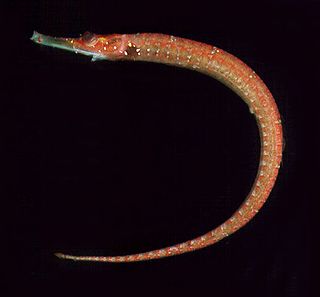
Cosmocampus maxweberi is a species of marine fish of the family Syngnathidae. It is found in the Red Sea from Sumatra to Tonga and Samoa, and from the Marshall Islands to the Great Barrier Reef. Adults live in reefs and reef-rubble to depths of 36 m, while planktonic juveniles have been found in the top 85m of 1500–2000 m water columns. Adults are expected to feed on small crustaceans, similar to other pipefish, and can grow to lengths of 10 cm. This species is ovoviviparous, with males carrying eggs until giving birth to live young.

Doryrhamphus negrosensis, commonly known as Negros pipefish, flagtail pipefish, Masthead Island pipefish or Queensland flagtail pipefish, is a species of marine fish of the family Syngnathidae. It is found in the Western Pacific Ocean, from Borneo to Vanuatu and the Yaeyama Islands to the Rowley Shoals and the Great Barrier Reef. It lives in mud flats and reefs, both coral and rocky, where it is often associated with sea urchins. It is a rather solitary species which may be found in pairs or small groups. It inhabits depths to 9 metres (30 ft), and can grow to lengths of 6.2 centimetres (2.4 in). Although little is known of its feeding habits, it is expected to feed on harpacticoid copepods, gammarid shrimps, and mysids, similar to other pipefish, it may also act as a cleaner fish like other species in the genus Doryrhamphus. This species is ovoviviparous, with males carrying eggs before giving birth to live young. Males may brood at 4.3 cm. It is a small bluish to bluish-grey pipefish which has a pale stripe along the dorsal side of the head and snout, and a dark fan-like caudal fin which has white margins and an orange base.
Dunckerocampus naia is thought to be a species of marine fish of the family Syngnathidae, although further taxonomic study is needed to determine if the classification is valid or if this species is synonymous with D. dactyliophorus. It is found in the Pacific Ocean, off of Japan, Guam, Indonesia, Fiji, and the Solomon Islands. It lives in caverns or under ledges amongst rocky or coral reefs at depths of 15–40 metres (49–131 ft), where it can grow to lengths of 12 centimetres (4.7 in). It is expected to feed on small crustaceans. This species is ovoviviparous, with males carrying eggs and giving birth to live young.

Booth's pipefish is a species of marine fish of the family Syngnathidae. It is found in the Western Indian Ocean, in South Africa and the Comoro Islands, and in the Western Pacific, from South Korea and Japan to the Great Barrier Reef and Tonga. It lives in rocks and coral reefs to depths of 30 metres (98 ft), where it can grow to lengths of 17.5 centimetres (6.9 in). This species is ovoviviparous, with males carrying eggs and giving birth to live young.
Gray's pipefish, also known as the mud pipefish or spiny pipefish is a species of marine fish of the family Syngnathidae. It is found in the Indo-Pacific in the Gulf of Aden, Sri Lanka, and from the Gulf of Thailand to Japan, the Marshall Islands, and the Great Barrier Reef. It lives to depth of 100 metres (330 ft), and planktonic juveniles have been found above depths of 3,000 metres (1.9 mi). It occurs in muddy habitats, in estuaries, and on coral reefs, where it likely feeds on small crustaceans. It can grow to lengths of 20 centimetres (7.9 in). This species is ovoviviparous, with males carrying eggs in a brood pouch before giving birth to live young.

The Samoan pipefish, or brown pipefish, is a species of marine fish of the family Syngnathidae. It is found in the Indo-Pacific, from the Red Sea, to Sodwana Bay, to Taiwan, the Marshall Islands, and Samoa, where it inhabits tidepools and coral and rocky reefs to depths of 15 metres (49 ft). It is a solitary species with cryptic habits and is rarely observed. It is likely to feed on small crustaceans, and can grow to lengths of 14 centimetres (5.5 in). This species is ovoviviparous, with males carrying the fertilised eggs in a brood pouch, the folds of which fall well short of the centre of the egg-filled pouch, eventually giving birth to live young.
The glittering pipefish is a species of marine coastal fish of the family Syngnathidae. It is found in the Western Pacific, from Viet Nam to Fiji and from the Ryukyu Islands to New Caledonia, where it inhabits corals, sand and reef flats to depths of 20 metres (66 ft).< It can grow to lengths of 7.3 centimetres (2.9 in), and is expected to feed on small crustaceans, similar to other pipefishes. It is secretive and rarely observed. This species is ovoviviparous, with males carrying eggs and giving birth to live young.
The spinysnout pipefish is a species of marine pipefish of the family Syngnathidae. It is found in the Indo-Pacific, from Sri Lanka to Samoa, and from Japan and the Marshall Islands to central Australia. It lives in rocky and coral reefs, rubble, lagoons and intertidal zones, often at depths of 2–12 metres (6.6–39.4 ft), where it can grow to lengths of 12 centimetres (4.7 in). It is expected to feed on small crustaceans, similar to other pipefish. This species is ovoviviparous, with males carrying eggs in a brood pouch before giving birth to live young.
Phoxocampus tetrophthalmus, the trunk-barred pipefish, is a species of marine fish belonging to the family Syngnathidae. This species can be found in reefs and tide pools of the Indo-Pacific specifically Indonesia, the Philippines, and Guam. They have also been observed in the Andaman, Cocos-Keeling, and Ryukyu islands. Their diet likely consists of small crustaceans Reproduction occurs through ovoviviparity in which the males brood eggs before giving live birth.
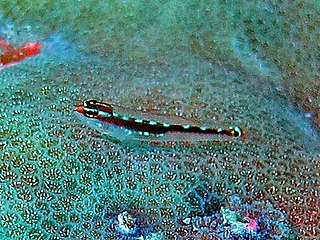
Eviota sebreei, common name Sebree's pygmy goby or striped dwarfgoby, is a species of fishes belonging to the family Gobiidae.














